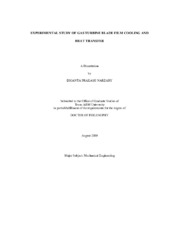| dc.description.abstract | Modern gas turbine engines require higher turbine-entry gas temperature to improve their
thermal efficiency and thereby their performance. A major accompanying concern is the heat-up
of the turbine components which are already subject to high thermal and mechanical stresses.
This heat-up can be reduced by: (i) applying thermal barrier coating (TBC) on the surface, and
(ii) providing coolant to the surface by injecting secondary air discharged from the compressor.
However, as the bleeding off of compressor discharge air exacts a penalty on engine performance,
the cooling functions must be accomplished with the smallest possible secondary air injection.
This necessitates a detailed and systematic study of the various flow and geometrical parameters
that may have a bearing on the cooling pattern.
In the present study, experiments were performed in three regions of a non-rotating gas
turbine blade cascade: blade platform, blade span, and blade tip. The blade platform and blade
span studies were carried out on a high pressure turbine rotor blade cascade in medium flow
conditions. Film-cooling effectiveness or degree of cooling was assessed in terms of cooling hole
geometry, blowing ratio, freestream turbulence, coolant-to-mainstream density ratio, purge flow
rate, upstream vortex for blade platform cooling and blowing ratio, and upstream vortex for blade
span cooling. The blade tip study was performed in a blow-down flow loop in a transonic flow
environment. The degree of cooling was assessed in terms of blowing ratio and tip clearance.
Limited heat transfer coefficient measurements were also carried out. Mainstream pressure loss
was also measured for blade platform and blade tip film-cooling with the help of pitot-static
probes. The pressure sensitive paint (PSP) and temperature sensitive paint (TSP) techniques were
used for measuring film-cooling effectiveness whereas for heat transfer coefficient measurement,
temperature sensitive paint (TSP) technique was employed.
Results indicated that the blade platform cooling requires a combination of upstream purge
flow and downstream discrete film-cooling holes to cool the entire platform. The shaped cooling
holes provided wider film coverage and higher film-cooling effectiveness than the cylindrical
holes while also creating lesser mainstream pressure losses. Higher coolant-to-mainstream density ratio resulted in higher effectiveness levels from the cooling holes. On the blade span, at
any given blowing ratio, the suction side showed better coolant coverage than the pressure side
even though the former had two fewer rows of holes. Film-cooling effectiveness increased with
blowing ratio on both sides of the blade. Whereas the pressure side effectiveness continued to
increase with blowing ratio, the increase in suction side effectiveness slowed down at higher
blowing ratios (M=0.9 and 1.2). Upstream wake had a detrimental effect on film coverage. 0%
and 25% wake phase positions significantly decreased film-cooling effectiveness magnitude.
Comparison between the compound shaped hole and the compound cylindrical hole design
showed higher effectiveness values for shaped holes on the suction side. The cylindrical holes
performed marginally better in the curved portion of the pressure side. Finally, the concept tip
proved to be better than the baseline tip in terms of reducing mainstream flow leakage and
mainstream pressure loss. The film-cooling effectiveness on the concept blade increased with
increasing blowing ratio and tip gap. However, the film-coverage on the leading tip portion was
almost negligible. | en |


